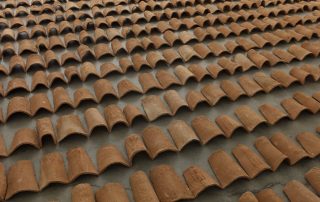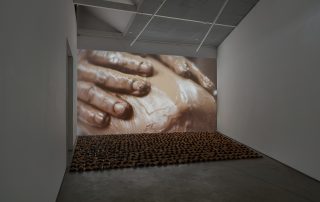Nas Coxas + Acima de tudo
Between September 1 and October 13, Luciana Brito Galeria is showing two new works by Héctor Zamora (Mexico City, 1974): Nas coxas [On the Thighs], a video installation that occupies the annex space, and Acima de tudo, a video produced based on the recording of an action carried out at the house.
Nas coxas is an unfolding of the action Capa e canal, staged in 2018 on the occasion of the 11th Bienal de Artes Visuais do Mercosul. For about two hours, men and women modeled approximately 700 clay roof tiles on their own legs. Seated on wooden stools, the 12 performers selected by Zamora produced a commentary on the popular expression “feito nas coxas” [literally, “made on the thighs”], a popular expression that denotes something made in a slipshod way. In the video installation, presented here for the first time, the pieces produced during the action are accompanied by a large-format video, produced on the basis of never-before-shown images recorded during the rehearsal of the action held in Porto Alegre.
The etymological origin of the expression “feito nas coxas” is as imprecise as its meaning. The most popular hypothesis is that it is associated with the manufacture of “ridge and channel” roof tiles, also known as the “barrel” type, much used in Brazil and constructions during the colonial period. According to this version, “fazer nas coxas” referred to the slaves’ lack of skill in the making of roof tiles, using their own thighs as molds. There is, however, another possible origin for the expression, based on the customs of colonial Brazil: in that period, when the practice of sexual relations before marriage was forbidden by societal norms, the expression made reference to an incomplete sexual act, carried out quickly and furtively.
In Nas coxas, Zamora makes provocations based on the border between the two meanings of the expression. On the one hand, the thesis anchored in the tradition of civil construction is questioned. In the video, the framings focused on the legs of the performers show our natural morphological variations, especially in a country like Brazil, where racial mixing is the rule. The material result of this heterogeneity is the set of roof tiles that we see in the video, forming a sort of impossible roof whose pieces are so irregular it has more gaps than areas of closed surface. On the other hand, the languor of the gestures, the viscosity of the materials and the sound of the movements imbue the tile-making process with sensuality, reinforcing the meaning linked to the socially unacceptable yet recurrent sexual behavior in colonial Brazil.
Even while it questions the thesis that it is possible to construct roofs on the basis of human thighs, the work also points to the physical effort that methods of rudimentary civil construction like those in our country have always demanded, until today. A high price has always been paid: in the past by the laboring slaves and, in the present, by the precarious worker, who is still part of the civil construction scene. Moreover, the semantic ambiguity instated by the artwork poses questions about the weight attributed to the possible origins of the expression. By investigating the popularity of the meaning linked to low-quality production by slaves, the action raises a question about who was ultimately responsible for the shoddy workmanship in our country. Was it the black slave submitted to forced labor, or the white master who used the body of that slave not only as a work tool but also, secretly, for his pleasure outside of working hours?
In a continuous action, on September 1 – the date of the release of Nas coxas – another artwork was produced. The action entitled Acima de tudo [Above All], a new site-specific work, was carried out at the gallery itself and is based on a reflection on the tectonic and sociological contradictions of Brazilian modernism. The video, which is a record of the action and has been part of the exhibition since September 20, features the participation of ten civil construction workers invited by Zamora to occupy the highest point of the building: the roof of the house’s second floor.
The Castor Delgado Perez Residence, today occupied by Luciana Brito Galeria, was designed in the 1950s by architect Rino Levi, one of the icons of Brazilian modernism. The building, which is developed mainly on the ground floor, is characterized by ample lighting and a high degree of permeability among the different household spaces, due to the near absence of opaque walls and a set of patios situated in its interior. The remodeling project carried out in 2016 to adapt the house for use as a gallery preserved many of its original characteristics, in keeping with the importance of preserving our Brazilian architectural heritage. The same conservation goal, however, poses challenges for artists like Zamora, whose poetics often considers the physical manipulation of the spaces where his works are to be developed. Aware of this, the artist opted for the strategy of dialoguing with this iconic space from the outside. To this end, as a platform for debate, Zamora chose the one part of the house designed in a very different style from the rest: the small upper volume facing the street. That space, located above the garage, is separated from the other parts of the house and is practically windowless – it only has small openings high on its wall facing the interior of the lot – characteristics that are counterposed to the transparency and permeability found everywhere on the ground floor.
As in Nas coxas, in which he plays with the meanings of the mythology surrounding the popular expression, once again the artist’s provocation is multiple in nature. On the one hand the action, carried out on the façade facing the street, promoted a temporary integration with the city that was nonexistent in the house’s original architecture. Totally open in its interior, it nevertheless has little or no dialogue with the surrounding urban space, which makes us think about how we relate with the public sphere of our country. Moreover, that windowless and segregated volume was originally designed to house the sleeping quarters of the housemaids, in a spatial configuration symptomatic of the relations between social classes in Brazil.
Seated on the platband on pieces of cardboard, throughout the day the ten workers could be seen talking and relaxing as if they were on their lunch break. Such naturalness, however, contrasts with our social reality. With their dark skins and work clothes, those men represented what the purity of the white volume once concealed. By spotlighting these men whose ancestors possibly helped, with their own bodies, to build and conserve the modernist heritage in Brazil, Acima de tudo sheds light on the deep roots of a heritage of slavery that the progressivist legacy of our tropical modernism has not managed to dissolve.
Helena Cavalheiro



